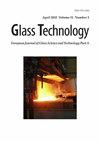Towards People Crowd Detection Using Wireless Sensor Networks
IF 0.3
4区 材料科学
Q4 MATERIALS SCIENCE, CERAMICS
Glass Technology-European Journal of Glass Science and Technology Part a
Pub Date : 2022-06-17
DOI:10.47672/ejt.1071
引用次数: 1
Abstract
Objective: The objective of this study was to examine and propose the use of wireless sensor networks for people crowd detection in resource constrained environments such as developing economies. Methodology: A systematic review was carried out on current technological trends and application of Wireless Sensor Networks (WSNs) in crowd detection. For this study, focus was on WSN implementation in developing economies, where infrastructure is underdeveloped and people crowds are dynamic and spontaneous. Based on a requirement analysis and knowledge of the inherent challenges of WSNs, a WSN implementation for people crowd detection was proposed. Findings: Most studies in crowd detection using WSNs, have been in the area of non-people crowds. However issues critical to deployment of WSNs for people crowd detection in developing countries include: the uncontrollable nature of people crowds, under developed physical infrastructure and the inherent challenges of power, computational capacity and broadcast communication characterizing WSNs. Achieving people crowd detection using WSNs therefore, calls for special attention. Recommendation: To ensure effective people crowd detection, requires taking into consideration connectivity, scalability, performance, security, accuracy and resource utilization of WSNs.基于无线传感器网络的人群检测研究
目的:本研究的目的是研究并提出在发展中经济体等资源受限环境中使用无线传感器网络进行人群检测的方法。方法:系统综述了无线传感器网络(WSNs)在人群检测中的技术发展趋势和应用。本研究的重点是发展中经济体中WSN的实施,在这些经济体中,基础设施不发达,人群是动态的和自发的。在需求分析和了解WSN固有挑战的基础上,提出了一种用于人群检测的WSN实现方案。研究结果:大多数使用WSNs进行人群检测的研究都是在非人群领域进行的。然而,在发展中国家部署用于人群检测的无线传感器网络的关键问题包括:人群的不可控性质、不发达的物理基础设施以及无线传感器网络固有的功率、计算能力和广播通信挑战。因此,利用无线传感器网络实现人群检测需要特别关注。建议:为了确保有效的人群检测,需要综合考虑wsn的连通性、可扩展性、性能、安全性、准确性和资源利用率。
本文章由计算机程序翻译,如有差异,请以英文原文为准。
求助全文
约1分钟内获得全文
求助全文
来源期刊
CiteScore
0.30
自引率
0.00%
发文量
0
审稿时长
>12 weeks
期刊介绍:
The Journal of the Society of Glass Technology was published between 1917 and 1959. There were four or six issues per year depending on economic circumstances of the Society and the country. Each issue contains Proceedings, Transactions, Abstracts, News and Reviews, and Advertisements, all thesesections were numbered separately. The bound volumes collected these pages into separate sections, dropping the adverts. There is a list of Council members and Officers of the Society and earlier volumes also had lists of personal and company members.
JSGT was divided into Part A Glass Technology and Part B Physics and Chemistry of Glasses in 1960.

 求助内容:
求助内容: 应助结果提醒方式:
应助结果提醒方式:


